Part 43: Interlude: Convair 880, Martin 2-0-2, Boeing B-17. (Spaced God)
Aw man, the A380. It is to extreme capacity what the Concorde was to extreme speed... and look where that ended up. ANYWAYS:Glazius posted:
I don't have any requests other than, before this is done, find something else you feel is worth talking about. I love me an effortpost.
Glazius, my friend, you have no idea what you just unleashed.
So Jaguars! is wrapping up his LP (which I can’t thank him enough for doing! TT-type games deserve more LPs) and I felt like I wanted to show him my thanks for not running me out when I sperged out about airplanes. So, have a personally-inspired piece or two…. Or three:
Part one: The Fastest Airliner in the World*
*for a time
So the running theme for these pieces is going to be “aircraft with which Spaced God has worked,” just because I feel that some stuff I’ve worked on has some interesting history behind it. They also were in the shadow of the big guys that got to get featured in the game. Our first exhibit has us going back to only a few years after when we left off from the Comet piece, around 1956. The Jet Age was now well and truly “a thing,” and in America companies like Boeing and Douglas had thrown themselves at the idea of an American jetliner. Meanwhile, Convair existed.
Convair was a subsidiary of the aerospace conglomerate General Dynamics (bought in 1953-ish), and they were mostly known for making things with one of two properties: unique, fast things or extremely boring things. On the former end, you had your delta wing fighters and bombers like the F-106 and the B-58. They also had the B-36 Peacemaker, the only American aircraft to carry an operational nuclear reactor and also one of my favorite airplanes. On the other end you’ve got their only forays into civil aviation, which were regional turboprops like the CV-240 family, which is only notable for killing Lynyrd Skynyrd.
But Convair saw the jetliner revolution we talked about last post and how much bank it was capable of making, so they threw their hats in the ring. They saw that the Comet, 707, and DC-8 were all hitting the same market: large people movers over long distance, and that the regional market was being left out. Logically then, there must be a market for a small, low capacity, short-to-medium range jetliner that can get people to places fast! Thus, an idea was born.
The aircraft was pretty neat. It took four civilian-converted J-79 jet engines (the same jets that powered military aircraft such as the F-4 and B-58 to supersonic speeds) and strapped them to a 39 meter long fuselage with wings spanning 36.5m. It could carry 110 pax 4400 km at 535 knots. You’ll notice I have yet to actually say the name of the aircraft, and that’s where things get funny. Over the three year design period of the project, Convair went through like a half dozen goddamned names. The first sketches were named the Skylark, then the Golden Arrow (but it was too close to Continental’s trademark on Golden Jet), then the Convair 600, and finally the Convair 880. Those two numbers both are because the aircraft cruises at 600 mph/880 feet/second, the fastest cruise speed at that time for a jetliner (granted there were only, like, 3
 ).
).Convair presented their idea to several airlines, and when Howard Hughes (who owned TWA) saw the 880, he was fucking in and ordered 3 on the spot. Hughes got involved in the design process (as he was wont to do), helped fly some test flights, and by 1960 the first 880’s were in service with Trans-World. A couple other airliners picked up on the plane, including Delta, Cathay Pacific, Japan, and a few others. Hell, the Navy converted one for a tanker and Elvis even picked one up for his own personal plane.
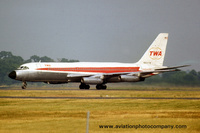
A Convair 880 on the takeoff roll. A lot of times when the 880 took of, the four CJ-79s would belch smoke in their wake
So by now you’re probably wondering where everything goes wrong and why you haven’t heard of this thing, and to be honest things went bad from square one. The engines they used were ungodly loud, inefficient, and smoky. This is because those engines were originally used on military planes which were mostly designed to go fast and not give a fuck about fuel efficiency. Moreover, the 5 abreast seating setup wasn’t particularly liked by any flight attendant. The biggest problem, though, was that the niche Convair tried to fill existed, but it was REALLY small. In total only 65 -880’s were built, and only 37 -990’s (Convair’s desperate attempt to make their design better) saw flight. At the end of the day, the Skylark/Golden Arrow/600/880/990/whatever project produced a whopping $190M…. In losses. Convair got out of the air transport market forever to go back to making missiles and rockets and fighters and do cool shit like land on the moon, meanwhile the remaining 880’s were left to rust.
Of the 65 -880’s built, I only know of six-ish airframes that are still intact-ish. Elvis’s plane, though not airworthy, is still floating around somewhere near Graceland. A few airframes were turned into corp jets until they either crashed or got scrapped, and one was even turned into a stripclub. The airframe I worked with was N803TW -- the same in that photo up there. She was a preproduction model (serial number 3) flown by Hughes to help sell the airplane. The museum owns the cockpit and the first-class bulkhead, and I did work restoring it to approximately what it looked like when it rolled of the assembly line in 1959.
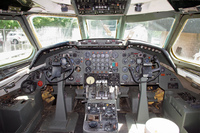
3TW’s cockpit circa 2013, before restoration. I had started working at the museum in 2014 and by Summer of that year the restoration work really picked up. I remember scrubbing out the inside of the bare metal in August when it was 30C outside and 60C inside. Not a fun memory.
The exterior of 3TW, probably around six months earlier than the above photo. Exterior work was done in Summer 2013, including the paint. Now, there’s a made-to-fit end cap on the cut end of the fuselage with power and ventilation holes implemented.
Part two: The Martin 2-0-2 (equals 0)
Let’s flash back earlier to 1945. There were a lot of post-war cargo airplanes coming back from the Pacific and European Theatres and converted to civilian use. The aircraft doing this in the biggest amounts was our good old friend the Douglas DC-3. Glenn Martin, president of the aircraft company bearing his name, wanted to build a replacement for these pre-war-era aircraft. Enter the Martin 2-0-2 (don’t ask me why it’s hyphenated).
From the outside, it seemed like a pretty good design. 71 feet long, 93 feet wide, 40 pax/9,270lb capacity, and two Pratt and Whitney R-2800 Double Wasps produced 1,800 HP each to pull the plane to a cruise speed of 178 mph at 12,000 feet over 630 miles. An interesting note is that the horsepower could be increased by about a quarter through water injection, which was common on military aircraft but not civilian propliners due to weight issues.
Here’s where things get weird. Not necessarily bad (yet), but weird.
The design of the aircraft also had some quirks. You see, most aircraft around this time (including our friend Convair’s CV-270 and Douglas’s DC-6) were starting to become pressurized to give passengers more comfort and to allow a higher cruising altitude. The 2-0-2… didn’t... for some reason. Moreover, the aircraft lacked batteries. This meant to operate the electric airstairs in the back after a flight, you would need to keep at least one engine running -- because everyone knows nothing can go wrong when you have a bunch of civilians on a tarmac with running engines.
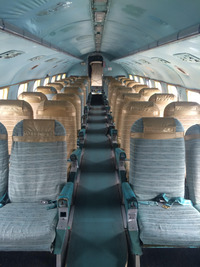
The interior of a Martin 2-0-2. Note the very small overhead bins -- they weren’t for luggage, but for hats!

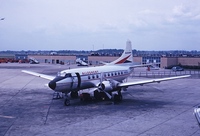
The same airplane as above circa July 1962 flying for Allegheny Airlines.
Electrical and pressurization issues notwithstanding, orders for the 2-0-2 flowed in. 137 orders were placed in the opening months from airlines big and small alike, including hard hitters like TWA, Northwest, and Delta.
And now here is where things go wrong.
The end of the 2-0-2 was a swift one-two punch. The first issue was the fact that the alloy used in the wing spars were prone to metal fatigue and corrosion. This led to a few instances of the wings just falling off mid flight. The entire fleet had to be grounded to fix this. The other issue was the fact that Martin had a clause in their contracts allowing the airlines to cancel their contracts at any time for any reason without penalty. This is dumb. These two issues, combined with the increase in faster, pressurized aircraft, put a nail in the coffin of the 2-0-2. Neither it or it’s successor the 4-0-4 were ever as successful as their competitors, and they faded into obscurity.
A total of 47 2-0-2s were produced in a span of about 11 months. After they had been rendered obsolete they lingered around with charter airliners, but by the end of the day most all of them were turned to pots, pans, and tin cans. And by “most all,” I mean exactly 46. Today, only one 2-0-2 airframe exists in anywhere in the world, and it’s at the museum at which I worked. In fact, it’s also the same aircraft in the pictures up there... again! She served for Allegheny in the 50’s and 60’s, and was donated to the New Jersey Aviation Hall of Fame in the 80’s. Today, she’s not in the best of shape: her interior is cracked and faded, her paint chipped, and her wings clipped to fit her into the exhibit area. However restoration is actively underway to bring her back to her former near-glory.
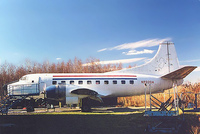
The exterior of 93204, from about 10 years ago. The paint’s since chipped and decayed, sadly.
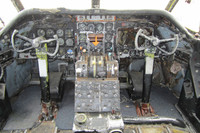
The cockpit of 93204 now. Hopefully we’ll get her back in shape. As an aside: I could rant for days about how the shapes of the knobs are completely different in this aircraft, which makes flying it at night super hard but I think this post is already getting long enough

Part Three: The Castle, the Porcupine, and the Gamble, all rolled into one
Okay, so this isn’t an airliner. BUT! I feel that this should be covered because A) this is connected because it involves a gamblin’ company we’ve talked about before, and B) I am in love with this airplane. Let’s talk about the B-17!
In 1934, the Martin (deja vu!) B-10 first entered service with the Army Air Corps (Air Force didn’t exist until 1947). It was the first all-metal monoplane bomber to be used by the USAAC and was pretty cool. The same year (don’t ask me why), the Corps wanted to prepare a replacement for their shiny new bomber. They had some pretty lofty (pardon the pun) requirements, too: Carry a useful payload for 10 hours at 200 mph for a period of ten hours, with “extra credit” goals including a range of 2,000 miles and an extra 50 mph to the cruise speed. The contract was sent to three companies -- Douglas, Martin, and Boeing -- with the winner to be determined via fly-off.
A few years prior, Boeing had lost a contract (see a running theme with these guys?) with the Corps to make the B-9, a really fucking slow, ungainly bomber converted from a mailplane. They had put a lot of money into that, and its rejection put the company perilously close to the financial brink. This time Boeing knew they had to do it right, and so they threw everything they had into this contract to create a design known as Model 299. The 299 took inspiration from the prototype XB-15 bomber and Model 247 transporter to create an absolute behemoth of a bomber.
For comparison, the Douglas and Martin prototypes both were underpowered twin-engined designs which barely met the contract specifications. The 299, on the other hand, sported four P&W 1690 Hornet engines producing a total of 3,000 HP which could carry 6,000 lbs of bombs 2,000 miles to a target. While the competitors each were armed with three 30-cal (7.62mm) Brownings and very thin armor, Boeing’s original design bristled with six 30’s (this was later upgraded to thirteen 50-cal’s) and armor plating. It also featured the a nifty, top-secret targeting device called the Norden Bombsight. I could talk about this guy for another four or five paragraphs, but I’ll shorten it by saying it is the most accurate mechanical bomb sight of all time, capable of putting a bomb in a 75ft circle from 36,000 feet. At the first public display in Everett, WA reporters were baffled by the sheer number of guns and amount of armor, with one exclaiming “Why, the thing’s a flying fortress!” Boeing engineers heard this, and jumped on the name… the Boeing B-17 Flying Fortress.
While getting ready to fly out to Ohio for the USAAC’s contest, the Fortress not only beat the other competitors to the airport, but also broke the world record for sustained speed during a cross country flight (2,300ish miles in 9 hours at an average of 252 mph). I can’t find any source to confirm this, but I assume the phrase “oh fuck” was said in certain aerospace company meeting rooms. During the fly-off, it became clear quite quickly that Boeing’s entry was miles ahead of what Douglas and Martin had put together. The four-engined bomber demonstrated super-long range capabilities at speeds and altitudes which were unheard of at the time. Despite the setbacks of the B-9, everything was coming up Boeing.
And then something awful happened. Again. (Last time I’ll type that, I swear!)
During the second evaluation flight, the crew neglected to remove the gust lock before beginning their flight. Gust locks are devices which prevent winds from moving the control surfaces, potentially damaging them, so they’re basically trying to drive a car with one of those steering wheel locks. The plane took off, lost control, and crashed killing all aboard. Boeing’s only prototype (and only chance at financial salvation) was quite literally going up in smoke. It also turns out that “crashing your airplane” is one of the things that immediately disqualifies you from winning a USAAC aircraft contract. So now Boeing was, like, quadruply fucked: No contract, no plane, no test pilots that knew how to fly said plane, and no money.
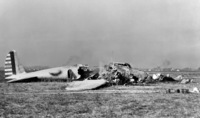
Pictured: how not to sell airplanes
However, the Corps were so impressed by the Fortress that -- even though the contract was awarded to Douglas -- 13 Fortresses were ordered. These aircraft were delivered in 1937 for operational testing, including the first intercept of an unknowing ocean liner by Curtiss LeMay. Some engine and fuselage upgrades later, the B-17A became operational in 1939.
Over the next six years, this plane would become the posterchild of Allied airpower. We first starting giving them to the RAF under lend-lease, who instantly fell in love with the design. Once America got involved in the war, a total of 4,500 Fortresses were spread to bases in both theatres. Through daylight raids consisting of thousands of bombers, over a 580,000 metric tons of ordnance was dropped on targets in Europe, the most of any aircraft in the war on either side. German pilots were so intimidated by the aircraft’s defenses, they referred to them as fliegendes Stachelschwein, or flying porcupines.
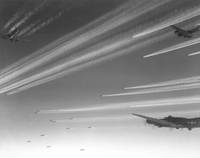
A daylight bombing raid. Raids often consisted of as many as 1,000 aircraft loaded with bombs
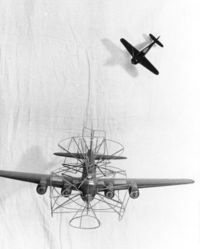
A Luftwaffe model showing the cones of fire for each of the B-17’s 13 guns. Not a whole lot of safe places to be if you’re on the outside…
12,731 aircraft were built from ‘36-’45, and a lot remained in service for years after the war. Others were converted for civilian use, including airliners, firefighting aircraft, cropdusters, and cargo carriers. However, despite being the third most produced heavy bomber of all time, there are only 10 flying in the world today. I had the privilege of working with three of these guys when they flew into airports I flew out of, EAA’s Aluminum Overcast, Yankee Air Force's Yankee Lady and Collings Foundation’s Nine-O-Nine. I even got a chance to fly one, which is my only aviation-based claim to fame. You can see some of these flying relics too if you’re in the states. EAA, Collings, and CAF fly all around the country and offer rides and ground tours (There are airworthy -17s in France and the UK but I don't know their operations). Supporting these aircraft is very important, because most cost an exuberant amount of money to keep flying (EAA’s bird runs them somewhere around $2M a year) and we need to keep these wonderful pieces of history in the skies.
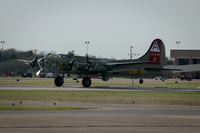
Nine-O-Nine, one of the last flying B-17s in the world. The symbol and letter on the tail was used to indicate the squadron the aircraft belonged to. The "A" in a triangle means she belonged to the 91st USAAF Bomb Group.
So, there you have it: a lotta words (this ended up being WAAAY longer than I expected it to be) and a little bit of self-indulgence. As I said up top, big thanks to Jaguars! for the thread, and everyone for liking my little spice I threw in between updates (in this case it’s less of a little spice and more the entire spice rack, though). I hope I taught y’all a little bit about aviation history, because it’s super cool. If you want more, go to an aviation museum and talk to people because that’s how I learned most everything I know. Or, if you’re too lazy to leave the forums, hop on over to the Aeronautical Insanity thread. As always, if you have questions about anything I’ve talked about, feel free to ask or PM.
But, I think the most important lesson we learned today is...
Glazius posted:
I don't have any requests other than, before this is done, find something else you feel is worth talking about. I love me an effortpost.
Don’t give me free reign, or you’ll get a long, rambly effort post tangentially related to the game
